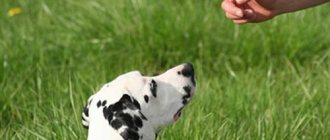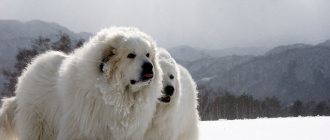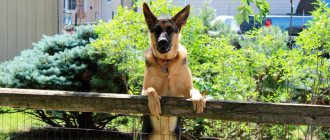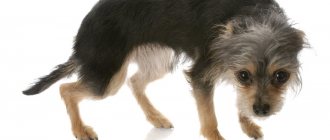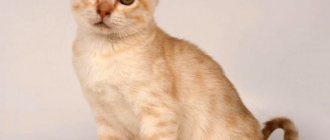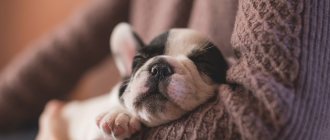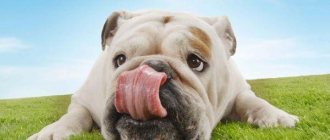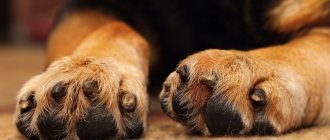Description of the dingo dog
The dingo is of medium size, its structure reminiscent of the grace of hound dog breeds. Her body is toned, with well-developed muscles. Everything about this dog is harmonious: from the tip of its nose to its tail. Thanks to the dense undercoat, dingoes are not afraid of frost and heat.
| Characteristics | Description |
| Height | Up to 65 cm, in rare cases higher |
| Weight | Up to 25 kg, in rare cases more |
| Head | The skull is flat. Elongated, square-shaped muzzle, powerful jaws, capable of holding game. Ears are erect. Eye color from light to dark shade of brown |
| Torso | Body length is about 120 cm. The tail is on average 35 cm long, sometimes slightly curled towards the back, fluffy |
| Color | The coat is thick and dense undercoat, the color is more common shades of red, less often black or gray |
| Limbs | Long, strong |
Dingoes can form packs of 12 or more dogs. Only one pair will be dominant in the flock; the rest must obey and help take care of the offspring.
Dingoes are graceful dogs and excellent hunters
Dingo dogs are very smart and active animals. When exterminating these dogs, various types of traps are used, which dingoes easily find and avoid. In addition to humans, wild dingoes have a serious enemy - the jackal.
What you need to know! Dingoes of pure blood never bark, but are capable of emitting wolf howls and chest growls.
Description of dingo
Externally, the dingo is a well-built dog, similar to a hound, of medium size: its height is from 47 to 67 cm, its body length is 86-122 cm, and its tail length is from 26 to 38 cm.
Weight ranges from 9-19 kg, sometimes reaching 25 kg. Males are much larger in size than females, but the Asian dingo is smaller than the Australian dingo. The dingo has a square-shaped muzzle with small erect ears. The tail is saber-shaped, pubescent. — Advertising —
The coat is thick and short, usually rusty-red or reddish-brown in color, lighter in the area of the muzzle and belly. Black, white and piebald dingoes are also found, but are rare. The grey-white subspecies is common in south-eastern Australia. The black and tan dingo, which is similar in color to the Rottweiler, is considered a hybrid with a domestic dog such as the German Shepherd.
A purebred dingo does not bark, but can growl and howl like a wolf.
History of the dog
The most widely accepted theory for the origin of the dingo in Australia is that it was supposedly brought by hunter-gatherer people from Asia. On the mainland, dogs abandoned by their owners have spread to hunt for food. Dogs formed packs - this made it easier for them to hunt local game. It is believed that this is what caused the extinction of many solitary marsupial mammals. It is believed that dingoes are a subspecies of the wolf, but some experts distinguish them as an independent species. There is also a version that dingoes come from the domesticated Indian wolf, which is common in the Indian subcontinent. In the 50s, a singing dog was found in New Guinea that closely resembles a dingo. Only its size is inferior to Australian dogs. The Carolina dog discovered in the United States of America also vaguely resembles a dingo.
Dingoes are considered descendants of the wolf
What you need to know! In the story “The Wild Dog Dingo, or the Tale of First Love,” written in 1939. Dingo dogs were first mentioned by R. Fraerman.
Habitat and lifestyle of the dingo dog
The dingo is common not only in Australia, but is also found in Southeast Asia. The dog is very active in the dark. The habitat of this breed is semi-deserts and eucalyptus forests. Dingoes like to settle in small cavities in the upper part of the earth's crust, under large root systems of trees, or occupy small underground tunnels that have been abandoned by other animals for some reason. Dogs also love to be located near bodies of fresh water.
In Asia, dingoes have to stay side by side with humans, periodically visiting various garbage dumps in search of food.
What you need to know! Wild dingoes in nature hunt small mammals; reptiles are even willing to feast on kangaroos and wallabies.
Due to their close proximity to humans, dingoes often raided cattle, so dogs began to be exterminated.
Dingoes are pack animals
Dingoes can live either alone or in groups. There are an average of about 12 dogs in a pack. Dingoes settle in a certain territory and then carefully guard it.
Where does the dingo live?
The dingo dog lives in Australia; it is widespread throughout almost the entire continent. The largest numbers of these animals are found in the northern, western and central parts of Australia. The dingo dog also lives in small quantities in Southeast Asia (Thailand, Myanmar, Philippines, Laos, Borneo, Indonesia, Southeast China, Malaysia and New Guinea).
The dingo is an Australian animal that is predominantly nocturnal. In Australia, the dingo lives mainly in eucalyptus thickets, semi-deserts and forests. The dingo dog lives in a den, which it usually makes in a cave, tree roots, empty holes, and most often not far from a pond. In Asia, the dingo lives close to humans, as it feeds on waste.
Purchasing a dingo puppy
Dingoes, due to their exotic appearance, are very difficult to acquire. Since the animal is wild and naturally not recognized as a breed, there are no nurseries in Russia. Even in zoos it is not possible to purchase a puppy. The fact is that in order to reliably provide appropriate care for the dog, it is necessary to conclude special contracts and draw up documents. The only option is to purchase a puppy abroad, for very small sums. A puppy can cost at least $600 excluding shipping.
What you need to know! Dingo dogs are wild animals that will never become domesticated without the necessary upbringing and training. The dog chooses only one person as its owner, and if the owner decides to refuse such a relationship, the dingo may die. Therefore, purchasing a dingo dog is a very important step, which can destroy the animal.
Puppies need to be socialized immediately
Things to consider before getting a dingo puppy:
- The dog is active, you need to walk with it for a long time, it does not tolerate long minutes of calm, it constantly needs movement.
- Dingo does not accept other pets.
- A cold attitude towards humans is normal for a dingo; it can only become attached to one member of the family.
- A dingo will never be your companion. It will be better for the dog to live in the spacious courtyard of a country house, where it can serve as guard.
- Dingoes are not fussy about their care; they only need to be bathed twice a year, not more often.
- Dingo is a carnivorous animal; it is worth considering a balanced diet, which will include meat porridge and vegetables.
Dingoes are very strong dogs that survive well in natural conditions. They have good immunity, but to live in the city they must be vaccinated, like all domestic dogs.
Unfortunately, a dingo will never become your best and faithful friend. These dogs will not let you get bored, and will always be eager to be free, because wild blood will always control them.
Video – Dingo family of wild dogs
Feeding a dingo dog
Dingoes are predators that prefer to hunt at night. In Australia, dogs can easily catch rabbits, possums, reptiles, rats, wallabies, birds and even kangaroos. They do not neglect to feast on carrion. Due to the lack of game for some reason, dogs attack livestock and poultry.
Asian dingoes' diet consists mainly of fish and meat scraps, vegetables and cereals. Due to poor nutrition, dingoes in Asia are small in size.
At home, feeding should be as close as possible to food in the wild. That is, the basis must necessarily be meat products. Also, the dog should always have a bowl of fresh water available. And you need to regularly add vitamins and minerals to your food. Especially when kept at home, dingoes suffer from a lack of zinc.
Dingoes are predators, so meat is the main diet
Caring for a Dingo Dog
Dingoes constantly require a lot of physical activity. It is necessary to constantly involve the dog in various hikes and explorations of new areas, otherwise the dingo may get bored and make a solo trip without its owner. Dogs also willingly participate in training where they need to overcome obstacles. If you notice a dog digging, this is a clear sign that the dingo is very bored. That is why keeping a dingo in an enclosure is a problematic task, because at any moment the dog can dig under the dingo and break free. During walks, the dingo must be on a leash, otherwise its enormous energy can turn into an escape action. If you manage to find an approach to the dingo, then it can be a good watchman and hunter for you. After a good hunt, hunters often reward their pets with small game for their help in the job and excellent behavior. You can’t count on a closer relationship, even though a dog becomes attached to only one person, detachment will always be in its blood.
The dog does not require special care, since dingo fur does not have a specific odor. You should comb your pet a couple of times a year to remove dense undercoat.
The dingo is easy to care for, she is independent, but also freedom-loving.
Mandatory annual vaccination is the key to your dog's health.
What you need to know! If you choose a dingo as a pet, never forget about its strong hunting instincts. Under no circumstances should you leave small pets, especially children, with her, because these dogs are completely unpredictable.
Character and behavior
Dingoes are very smart, agile, hardy dogs with excellent eyesight and hearing, and a developed pack and strong hunting instinct. They are very careful and careful by nature, which allows them to avoid meeting people, traps and recognize poisoned food. Purebred dingoes do not bark, they only howl and growl.
It is believed that dingoes do not attack humans. Throughout history, only a few such cases have been recorded. One of the most notorious was the death of Azaria Chamberlain, a 9-month-old girl who is believed to have been dragged away by a wild dog.
Tamed dingoes are mischievous, smart and cheerful. They become strongly attached to one person and cannot tolerate a change of owner, running away or dying. Other family members are usually treated friendly. They are prone to escape and unpredictable in behavior. They do not get along well with other animals. Conflicts often arise with dogs; other animals can awaken the hunting instinct. When alone or without attention, they quickly run wild.
Character and characteristics of upbringing
Dingoes have a complex temperament and a rebellious character; they are difficult to raise, and few people have managed to tame them. Dogs cannot stand being tied up and will constantly try to free themselves from the bonds. Even if from the outside the dingo looks absolutely calm, this will not stop it from attacking a person in the presence of its owner. Therefore, it is worth considering the wild habits of this animal and always be attentive. However, Australian dingoes do not get along well with a single owner, whom they will serve without delay.
The owner of a dingo must be prepared for the difficult, time-consuming journey of raising his pet.
Dingo's character is unpredictable
Reproduction and life expectancy of the dingo dog
Dingoes are school animals, but only one pair, which is dominant, will have the right to reproduce. The remaining members of the pack will only be able to help and show care when the puppies appear. Power in the pack is established through constant showdowns.
Dingoes breed only once a year: in Australia the mating season is from March to April, in Asia from August to September. Pregnancy lasts about nine weeks, at the end of which six to eight babies are usually born. Babies are born completely blind and covered with fur. All members of the pack participate in raising the puppies.
By the end of the third week, the puppies take their first steps out of the den and also switch to adult food. Up to twelve weeks, the puppies are fed by the pack, regurgitating prey for the babies. Upon reaching four months, puppies become absolutely independent and help adults in search of prey. Dingoes become sexually mature between the ages of one and three years, and choose one partner for the rest of their lives.
The puppies are raised and fed by the whole pack
On average, the lifespan of dingoes in captivity is up to thirteen years, while in the wild they live about ten.
What you need to know! In a flock, only the main couple has the right to reproduce. Mating occurs no more than once a year. If a puppy appears in the pack that is not from the main female, then she eliminates it. While the babies of the main pair grow, they are raised and fed by all members of the pack.
Interesting facts about wild dingoes
In captivity, dingoes are often bred with other dogs, resulting in hybrids. In modern times, purebred dingoes inhabit the national parks of Australia. All hybrids are much more dangerous than wild dingoes. Their character combines the wildness and aggressiveness of dingoes and the ability to bear offspring 2 times a year from domestic dogs.
Dingo breeding
Dingoes are monogamous animals.
In a small flock that dingoes form for life, only the dominant pair reproduces. If another female gives birth to cubs, the dominant one kills them. Thus, all other members of the group are left only to care for the offspring of the dominant pair. The mating season for dingoes occurs once a year. In Australia - in March-April, in Asia - in August-September. Pregnancy lasts 63 days. The female gives birth to 6-8 puppies, blind but covered with fur, in a special den. Both parents take part in raising their offspring.
3 weeks after birth, the babies leave the den for the first time, and the female finishes milk feeding. At 8 weeks, young dingoes begin living in a pack. For about another month, the mother and other members of the pack help them with food and water, but at the age of 3-4 months the puppies begin to hunt independently, along with adults. They become sexually mature at 1-3 years. Life expectancy in natural conditions is about 10 years and up to 13 years in captivity.
In addition, dingoes can easily interbreed with domestic dogs and produce “hybrid” animals. Such offspring are characterized by breeding twice a year and a higher level of aggressiveness, which is especially bad for livestock.

